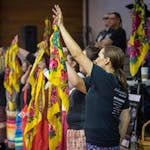Alexis Oberdorfer was named president of Children's Home Society of Minnesota just over two months ago at a time of massive changes, including a drastic decline in international adoptions and a huge upswing in the need for families of older children, many facing emotional challenges. Even adoption language is changing. Oberdorfer has served in child welfare roles for more than 25 years. She was raised in the Twin Cities by adoptive parents after her 16-year-old biological mother "made a compassionate decision to make an adoption plan," and is the mom of three children — two adopted and one biological. She talks here about what hasn't changed: her organization's mission to help all children thrive.
Q: How's the new job treating you?
A: Really well. I have such a fierce passion for what we do. There are few things that rival helping children and youth find permanent and loving homes.
Q: What are the biggest challenges facing Children's Home in 2020?
A: We are facing a tremendous need to find families to care for and nurture children in foster care. Right now in the Minnesota foster care system, there are 905 children who are legally free for adoption and they need an adoptive family. We know that youth who don't have permanency and age out face poor outcomes that include decreased graduation rates, underemployment, homelessness, substance abuse and unplanned pregnancies.
Q: What myths would you like to bust right here?
A: One myth is that adoption is expensive. Families interested in adopting children in foster care have almost no out-of-pocket costs. Additionally, children who are eligible may receive adoption assistance, and expenses paid during the process may be reimbursed. Another myth is around who can adopt. You don't have to be married or own your own home. Regardless of race, faith, sexual orientation or gender identity, we can work with you on a home study and support you through the process.
Q: Adoption of newborns, once common, is rare now. What's the reason for the decline?
A: Birthrates are at an all-time low in the United States. Also, more parents with unplanned pregnancies are deciding to parent their children rather than place them for adoption. That means a larger percentage of children and youth waiting for adoption are children of color, sibling groups and kids with identified needs. Some children have experienced abuse, neglect and/or prenatal exposure to alcohol or drugs that may impact their behavior. Parenting children with these backgrounds will likely mean helping them manage behaviors, feel secure while they make sense of their past and foster resilience. We provide a number of resources for families, including support groups, a family support coach and referrals to therapists.
Q: Adoptive parents are still mostly white. How do you tap into a more diverse pool that reflects the children you serve?
A: We have been targeting families for children of color, more specifically focusing on African-American children, children of two or more races and LGBTQ youth. We are actively making connections to partner with faith communities, organizations and businesses to help us get the word out.
Q: When did open adoption become the norm?
A: Many would say that "open adoption" began in the 1980s. Through openness, children grow up without secrets and with information about their birth family. Developing these relationships really helps lessen some of the loss that both adoptees and birth parents commonly experience. It's also helpful to understand the biological connection and identity formation. Who do I look like? Does cancer run in the family? Does anyone share my interests and talents? This is just another way to meet and support the needs of children by having two loving families come together.
Q: Isn't it getting harder to keep these connections secret in the age of social media searches?
A: In adoptions created long ago that were commonly closed, birth parents may falsely assume that their identities will be kept anonymous. We believe this is becoming a thing of the past as DNA searches are becoming more prevalent. Social media is also playing a key role in connecting parties that were not as easily connected in the past.
Q: The language of adoption is evolving, too. Why is that?
A: Words matter! In our work, we've learned that some terms can be hurtful. Today, "expectant parent" is commonly used for individuals or couples making an adoption plan. "Birth parent" or "first parent" are terms used after an adoption.
Q: Are birth fathers more involved?
A: We find that it's more common for birth fathers to actively engage in decisionmaking today. Some may exercise their right to parent, while others may help identify an adoptive family and be part of the match meeting, the adoption process and openness afterward.
Q: What would you like to say to people considering adoption?
A: If you have an open heart, open mind and open home, we really need families like yours! There are so many kids who need a family. Whether you are parenting for the first time, growing your family or have just become an empty nester and have room for one or two more, come explore our programs (chlss.org) and find the right fit for you.



![Brock Ray of New Hope worked alongside his daughter Bonnie, 7, to line up materials for the feminine hygiene kits. ] ANTHONY SOUFFLE • anthony.](https://arc.stimg.co/startribunemedia/V7NEHZM6GZ2X6LNJ3HORH5RERE.jpg?w=75&h=75&fit=crop&crop=faces)

